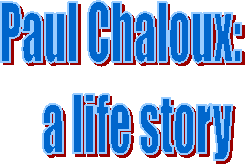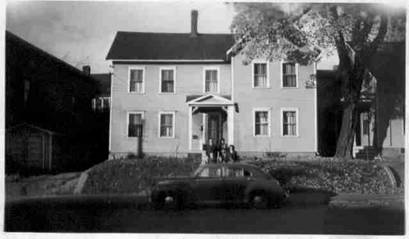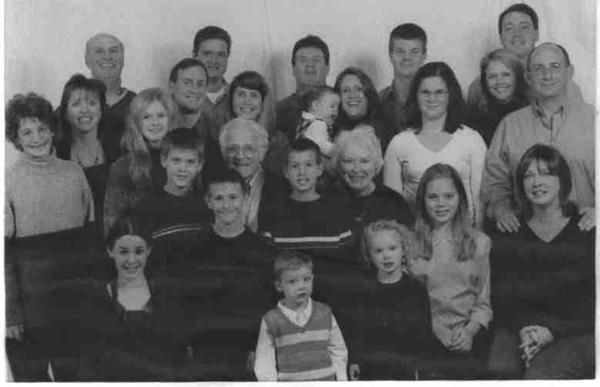


Paul Chaloux



Updated: October 29,2011 by Paul Chaloux, Jr
Paul Normand Chaloux was born on
Family was always very important to the Chalouxs.
Paul’s father Andre was the youngest of 23 children.
Because Andre’s father passed away when he was only one,
much of his raising was done by his
siblings. In fact, when he had
traveled to Lewiston for the first time, he stayed with his brother Silva
and helped take care of his children
after his first wife died. Andre kept in
contact with all his relatives and very rarely missed a family event. There was
a lot of extended family in the
Paul’s father was intelligent but uneducated, having less than one year
of formal schooling. He had many
jobs in his early life, working as a laborer, a carpenter and training as a
barber. In about 1934, Paul’s
father opened a combination barbershop and corner store on Sabattus Street in
Lewiston, while the family still lived on Orange Street opposite St. Mary’s
hospital. The family was a
typical French-Canadian family, speaking French at home and practicing the Roman
Catholic faith. Andre was very active in
the Knights of Columbus and Leona was from a very religious family.
Several of Paul’s cousins entered the religious life. The family was
generally financially stable, although never very well off.
Andre was very handy and fixed up
tricycles and pedal cars for the children. On a few occasions, they would make a
parade of them. Through age 6, Paul’s life was happy and very much like those
around him.
Shortly after Irene’s birth in 1936, Paul’s mother contracted
Tuberculosis which fundamentally changed everything in their lives.
By 1938, as Leona’s illness intensified to the point where she needed
full time care he could not provide,
Andre placed her in the Hebron Sanitorium, a facility
specializing in tubercular care.
To create a more steady income, Andre sold his business and took a job at
one of the local shoe factories.
Because he was unable to work and care for his young children, Andre placed his
sons in the Healy Asylum, a nun-run, state-funded orphanage and his daughters in
the similarly run Marcotte Home for young girls.
Paul lived the next six years in this arrangement, staying in the
Asylum during the week with his brother Andy and spending some weekends at home
with the rest of the family.
Because he was older, his brother Marcel was placed with the older children at
the Asylum for two and a half years before going back to live with his father to
help out around the house.
The Asylum was an all inclusive home.
School was on the grounds, taught by the Grey Nuns and the children lived
in barrack style
dormitories. The children were well
fed and besides school attendance and related activities such as choir and band,
they played sports like baseball and hockey for amusement.
There were annual picnics and holiday celebrations since some of the
children had no homes to go to. In
those days there were no frills.
Paul’s brother (Andre L) remembered the nuns feeding them warm toast for lunch
which was a rare treat. Paul would
see his mother on rare occasions at the sanatorium until she was released to
come home.
His time at the orphanage
certainly had an effect on Paul, many of them positive.
The Asylum routine included going to daily mass.
Paul was an altar server and for a while, many of his relatives thought
he might become a priest. He also learned a love of music, learning to play the
guitar at the age of 12 or 13. In
1940, Paul’s father moved the family to a house on
In 1944, Paul’s time at the Healy Asylum came to an end.
Because his mother was not improving at the Hebron Sanitarium, Andre
brought her home and at the same time brought home the older children to help
care for her. Paul helped out
the family finances by delivering the Lewiston Daily Sun each morning before
school. Finally, on
The next year was a year of transition for the family.
With the war over, Andre returned home from the Shipyard without a job.
He supported the family through his work as a carpenter and then borrowed
money from the bank and with the help of his sons, added eight apartments and a
barber shop and a beauty salon, which was later operated by Paul’s sister Irene,
to his
About this time, Paul entered
When he entered high school, Paul decided to add the clarinet and
Saxophone to the guitar he already played.
He continued to play in the high school band and used his talents with
the guitar, clarinet and saxophone to earn a few dollars by playing for dances,
weddings and wedding showers which were very popular at the time.
He was the leader of a band called “The
Moonlight Serenaders.” He
also played with other musicians when they needed a sax or clarinet player.
Most of his gigs included Paul on Clarinet, Sax and guitar, Andy on
trumpet, a friend on accordion and another friend on drums.
They all enjoyed Dixieland music and would often have jam sessions
playing Louis Armstrong music.
.
Although Andre always encouraged his children to pursue the best
education possible, at the time of Paul’s graduation in 1950, college was not
affordable. After high
school, Paul went to work as a machine operator at a paper mill for about a
year. Not finding that to his
liking, he took a job working at one of the local shoe factories.
As with all the members of his family,
Paul continued to live in his parents’ home when he lived in
In 1955, Paul’s sophomore year at college, he met Dolores Murdock at a
Saturday night dance at the
In 1957, Paul’s father learned that he had bone cancer.
This became a real concern for the family.
One day, while Paul was doing prescribed exercises on his father’s leg,
his leg broke at the femur (obviously weakened by the cancer).
The cancer had advanced to a point where a leg amputation was necessary.
This was a tragic turn of events, and a severe shock for Paul.
Andre, who had an indomitable spirit born from a life of hardships, was
determined to carry on.
Shortly after losing his leg, Paul’s father walked his youngest daughter, Irene,
down the aisle at her wedding.
Irene remembers that this sight caused everyone in the church to cry, making it
seem more like a funeral than a wedding.
.
Upon graduation in 1958, Paul went to work at United States Gypsum in
In Mid 1961, the family had a significant setback as Paul was laid off
from US Gypsum with a second child on the way.
He found a job working as a civilian engineer for the Army at the
During his six years at the
Through this period, the health of Paul Jr. continued to be a major
concern. His heart defect did not
allow him to even walk around the block with the family.
After a delay because of the measles, on
In June 1967, Paul took a promotion, transferring to
After the birth of Maria, Paul decided to take on a major building
project, adding on two more bedrooms and a large screened-in porch to the house
on
The children grew up in an athletic environment.
The family always had a ping pong table and both Paul and Dolly played
with the children. As the family
grew older, Paul would also take them to play tennis.
A basketball hoop was put up in the driveway and all the children played
regularly. There were also lively
games of football, stickball, baseball, wiffleball, kickball and dodgeball in
the street, in the backyard and at the local elementary school every day.
Around 1972, Paul took on another major project and added a large above
ground pool with a large wooden deck to the backyard.
The pool had a slide and a diving board and was a major source of
entertainment for the family and the neighbors as long as they lived in the
house. When the children got older,
they started playing and in some cases, starring in the local basketball and
baseball leagues. Eventually, most
of the children played varsity
sports at
Family was always important to Paul and he was a very hands-on father.
Paul and Dolly were a team in raising their children sharing many of the
daily household responsibilities including cleaning, diaper changing,
babysitting, carpooling, homework etc. Paul evolved to be the family grocery
shopper and was better than most in finding the bargains each Saturday often
visiting 3-4 grocery stores to accomplish it.
This was an errand that Maria enjoyed sharing with her father and they
grocery shopped together every Saturday.
On occasion, Paul would take Maria to McDonalds for breakfast while they
were out, a rare treat being a part of a family of 8.
Paul and Dolly always emphasized academics with their children and
instilled a desire to go to college at a very young age.
They had an incentive program where they would bring any child out to
dinner if they got straight A’s on a report card, a rare treat in a large
family. Likewise, they emphasized saving money for college and would double any
money that the children put in the bank for that reason.
This paid off, as all 6 children graduated from college and developed
solid careers. They also emphasized the Roman Catholic faith, saying grace at
meals, having family prayers, and bringing the family to weekly mass and monthly
confessions.
Although they never taught religious education, they did offer their homes for
classes. The family also was taught
to chip in at home and every child had weekly chores to do, according to their
interests and ability. With the
exception of Paul Jr., who had a second open heart surgery in 1977 and Janet,
who had a ruptured appendix, the family was remarkably healthy with very few
trips to the emergency room and only minor illnesses.
Living in
In the mid 1970s, Paul took one more promotion, moving from
In 1978, as Paul Jr. went off the college, the family moved one last
time, to
Over the years, Paul had many opportunities to show his patience with his
children. In 1988, while looking
for a job after graduating from college, Mike moved back home.
On one nice late summer day he decided that he wanted a convertible.
Instead of buying a convertible, he had a better idea.
He took his Chevy Malibu to his friend “Gumby’s” house and cut off its
roof. As Mike described it, “It was
great. I remember driving it home
and getting strange looks from people as I drove past.
When I got home, I will never forget the look on my father’s face.
It was classic. He was
standing at the bottom of the driveway as I pulled in.
He looked up and with a slight smile, shook his head in disbelief.
I said “Hey dad, how about this?”
He asked one simple question “What are you going to do when it rains?”
Just then I realized that my car and my plan had a big hole in it.”
Paul also could offer sage advice.
When Richard was struggling in his second year in Physics at
As time passed, family members
began to pass on. The first was
Paul’s sister Claire, who died in 1972 at the age of 42 from a heart attack.
This highlighted a family tendency toward high cholesterol that made Paul
spend over 30 years as part of an NIH study on cholesterol-reducing drugs like
the statins. In 1976, Dolly’s
mother passed away from a stroke.
After this, for several years, Dolly’s father Joe Murdock spent several months a
year with the family. In 1985,
Paul’s father died after a long battle with Alzheimer’s Disease, followed 2
years later by his step mother, Marguerite, who had skin cancer.
Finally, in 1992, Dolly’s father passed away after a long illness.
Starting in 1986, the family started to grow again.
On
In 1992, as the last of the children graduated from college and moved
away, Dolly retired from her job at
With the children out of the house, Paul and Dolly started spending a
significant amount of time on the road, visiting their children, siblings and
just taking vacation. Family
continued to be very important.
Once a year, the entire family, up to 25 members, got together and rented
a beach house somewhere. In
addition, Paul and Dolly spent a few weeks every year in
On his 75th birthday in 2007, the family had a large party at
Maria’s house that was very well attended by friends and family.
In August, Paul and Dolly went on a cruise with over 20 family members in
celebration of Irene and Louis
Boucher’s 50th anniversary and Paul and Sue’s 20th
anniversary. Unfortunately,
in October 2007, Paul had a major
stroke caused in part by Plavix that he was taking for his cardiac bypasses.
He was touch and go for many days but ultimately survived.
He was left with aphasia and some loss of peripheral vision that left him
unable to drive or read, limitations that clearly frustrated him.
Nevertheless, he regained his
health and returned to walking everyday.
For the next few years, Paul and
Dolly continued to travel to various family functions including high school
graduations for their five oldest grandchildren,
yearly trips to
The last week of 2010, Dolly had a minor stroke and Paul had a heart
attack during the same week. Paul
needed a quadruple bypass and an aortic valve replacement to correct the
problem, which he had on January 31, 2011.
The surgery was a technical success but Paul was incoherent for almost 2
weeks following the surgery.
When he came out of it, he started to be affected by Alzheimer’s.
Even though he had memory difficulties, he continued to clean the house
and go on walks. In August,
Paul and Dolly went to the beach house with the family in Bethany Beach Delaware
and a couple or week’s later they
went to Maine with Rich, Paul, and Maria to visit family.
On September 11, the family gathered again for Dolly’s 80th
birthday and a great time was had by all.
Sadly, on October 25, Paul had a major stroke and on October 29, 2011, he
died surrounded by family while having this story read to him.
Throughout his life, Paul was consistent with his ideals and his
upbringing. His love of family and his faith were the center points in his life.
He was a devoted son, brother, husband, and father.
He passed on the fundamental beliefs that he learned from his father to
his children which included the importance of family, faith, hard work,
education, and athletics. He
taught these things not only with words, but with the way he lived his life.
Even his death was a celebration of family and faith, where the whole
family came together to pray and relive the lessons he taught.
Paul’s parents,
Andre and Leona, on their
wedding day:

Paul and his siblings: Irene, Marcel, Claire and Andy in
front of the Orange Street House in 1939.

The Chaloux’s in front of the Webber St
House in 1940

Paul leading the Healy Asylum parade on 
Paul’s father’s store on

Paul’s father’s house on

The house after the addition of the barber shop:

Paul at age 3
and at age 15:

Dolly and Paul’s High school graduation pictures

Paul’s family in 1943 with his parents

Paul’s family in 1947 with Marguerite:

Paul and Dolly on their Wedding day in front of

Paul and Dolly with their parents on their wedding day:

Paul and Dolly’s first apartment on


Paul and Dolly’s family
in 1985 (at Andre Chaloux’s funeral)

The extended family in 2005:
